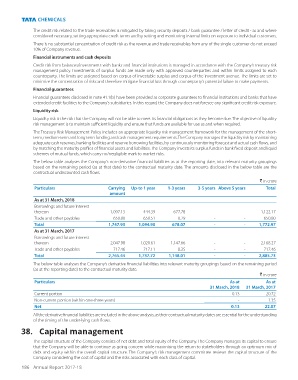Page 188 - Tata_Chemicals_yearly-reports-2017-18
P. 188
The credit risk related to the trade receivables is mitigated by taking security deposits / bank guarantee / letter of credit - as and where
considered necessary, setting appropriate credit terms and by setting and monitoring internal limits on exposure to individual customers.
There is no substantial concentration of credit risk as the revenue and trade receivables from any of the single customer do not exceed
10% of Company revenue.
Financial instruments and cash deposits
Credit risk from balances/investments with banks and financial institutions is managed in accordance with the Company’s treasury risk
management policy. Investments of surplus funds are made only with approved counterparties and within limits assigned to each
counterparty. The limits are assigned based on corpus of investable surplus and corpus of the investment avenue. The limits are set to
minimize the concentration of risks and therefore mitigate financial loss through counterparty’s potential failure to make payments.
Financial guarantees
Financial guarantees disclosed in note 41.1(b) have been provided as corporate guarantees to financial institutions and banks that have
extended credit facilities to the Company’s subsidiaries. In this regard, the Company does not foresee any significant credit risk exposure.
Liquidity risk
Liquidity risk is the risk that the Company will not be able to meet its financial obligations as they become due. The objective of liquidity
risk management is to maintain sufficient liquidity and ensure that funds are available for use as and when required.
The Treasury Risk Management Policy includes an appropriate liquidity risk management framework for the management of the short-
term, medium-term and long term funding and cash management requirements. The Company manages the liquidity risk by maintaining
adequate cash reserves, banking facilities and reserve borrowing facilities, by continuously monitoring forecast and actual cash flows, and
by matching the maturity profiles of financial assets and liabilities. The Company invests its surplus funds in bank fixed deposit and liquid
schemes of mutual funds, which carry no/negligible mark to market risks.
The below table analyses the Company’s non-derivative financial liabilities as at the reporting date, into relevant maturity groupings
based on the remaining period (as at that date) to the contractual maturity date. The amounts disclosed in the below table are the
contractual undiscounted cash flows.
` in crore
Particulars Carrying Up-to 1 year 1-3 years 3-5 years Above 5 years Total
amount
As at 31 March, 2018
Borrowings and future interest
thereon 1,097.13 444.39 677.78 - - 1,122.17
Trade and other payables 650.80 650.51 0.29 - - 650.80
Total 1,747.93 1,094.90 678.07 - - 1,772.97
As at 31 March, 2017
Borrowings and future interest
thereon 2,047.98 1,020.61 1,147.66 - - 2,168.27
Trade and other payables 717.46 717.11 0.35 - - 717.46
Total 2,765.44 1,737.72 1,148.01 - - 2,885.73
The below table analyses the Company’s derivative financial liabilities into relevant maturity groupings based on the remaining period
(as at the reporting date) to the contractual maturity date.
` in crore
Particulars As at As at
31 March, 2018 31 March, 2017
Current portion 0.13 20.72
Non-current portion (within one-three years) - 1.35
Net 0.13 22.07
All the derivative financial liabilities are included in the above analysis, as their contractual maturity dates are essential for the understanding
of the timing of the under-lying cash flows.
38. Capital management
The capital structure of the Company consists of net debt and total equity of the Company. The Company manages its capital to ensure
that the Company will be able to continue as going concern while maximising the return to stakeholders through an optimum mix of
debt and equity within the overall capital structure. The Company’s risk management committee reviews the capital structure of the
Company considering the cost of capital and the risks associated with each class of capital.
186 Annual Report 2017-18

